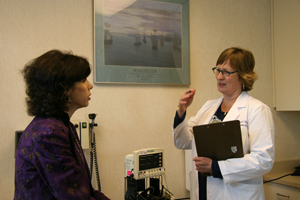January 25, 2010 - By Erin Digitale
The chief of the Stanford-LPCH Vaccine Program has devoted her career to finding better ways to prevent influenza pandemics

Cornelia Dekker (right), professor of pediatrics in infectious disease, is investigating a strategy that could stretch vaccine supplies: adding an adjuvant to the H1N1 vaccine to boost its effectiveness.
When Cornelia Dekker, MD, was an intern in 1976, a surprise outbreak of swine flu at Fort Dix, N.J, set health care providers scrambling to immunize Americans against a possible epidemic. Instead of causing widespread disease, the virus disappeared as unexpectedly as it had come, piquing Dekker’s interest in the mysteries of influenza.
After three decades of studying viral infections, Dekker, now professor of pediatrics in infectious disease at Stanford, again finds herself trying to understand swine flu. This time, unlike 1976, the flu’s spread has reached pandemic levels. Yet its mysteries haven’t lessened.
“You can plan all you want, but nature always provides us with a unique experiment,” said Dekker, also an infectious disease specialist at Lucile Packard Children’s Hospital and medical director of the Stanford-LPCH Vaccine Program.
Dekker is a widely recognized authority on vaccines and serves on the National Vaccine Advisory Committee, which oversees national vaccine issues and sets research priorities.
She said public health experts had fully anticipated an epidemic of deadly avian flu, but the H1N1 swine flu startled everyone when it appeared in April. This pandemic has delivered other surprises, too—physicians are relieved the disease is less lethal than expected, but frustrated that H1N1’s slow growth in the lab delayed vaccine production and led to national vaccine shortages in the early stages of the public campaign.
Dekker’s team at the Stanford-LPCH Vaccine Program is now investigating a strategy that could help stretch vaccine supplies. As part of a large multi-center trial funded by the NIH, in part with federal stimulus funds distributed via the American Recovery and Reinvestment Act, the team is evaluating whether injecting an immune-stimulating substance called an adjuvant could boost the vaccine’s effectiveness in producing antibodies. If the trial works as hoped, it could allow doctors to immunize with smaller vaccine doses.
The team recruited 126 adult volunteers for the adjuvant-plus-vaccine test—just a fraction of the several hundreds of people from Palo Alto and Menlo Park who responded when the trial was announced in August.
“We were very fortunate. A lot of people wanted to help science,” Dekker said. “Some of them, especially our elderly volunteers, were interested because they wanted to be protected against the H1N1 flu and didn’t think they would have another chance to receive the vaccine.” Unlike seasonal flu vaccine, H1N1 shots are being given to the elderly last, since older folks may have more natural resistance to swine flu than other population groups.
While she’s following the trial volunteers, whose immune responses will be monitored for a year, Dekker is also participating in public discussions about the pandemic. She has been working with local and national press as part of an effort to help dispel myths about the H1N1 vaccine. In particular, Dekker worries about people who are avoiding the vaccine because of misconceptions that it is riskier than seasonal flu vaccine. The seasonal flu vaccine targets different flu strains each year, but uses the same manufacturing process that was used for the H1N1 shot. The process, and the vaccines it produces, both have excellent safety records.
“In fact, if the H1N1 cases identified in April had been seen earlier, H1N1 would have just been tucked into the regular flu vaccine,” Dekker said.
Those who are still not immunized shouldn’t view reports that H1N1 cases have peaked with complacency, she added. Influenza pandemics often come in two waves: an early peak in the fall, and then a second, sometimes more severe, peak in spring.
“None of us has a crystal ball, but theoretically we are just starting to come into the beginning of our normal flu season,” Dekker said. So it’s still wise to get vaccinated. “I’ve spent my whole career studying vaccination, and I’m a strong, strong believer in the value of that prophylactic protection—the ability of vaccines to protect people from getting sick.”
For scientists monitoring H1N1, Dekker thinks the flu pandemic may have a few more surprises up its sleeve. “Will this virus settle in and become the dominant strain of flu, as has happened after prior pandemics?” she said. “Or will it develop another mutation that will change the whole picture?”
About Stanford Medicine
Stanford Medicine is an integrated academic health system comprising the Stanford School of Medicine and adult and pediatric health care delivery systems. Together, they harness the full potential of biomedicine through collaborative research, education and clinical care for patients. For more information, please visit med.stanford.edu.